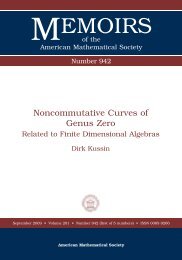University of Paderborn Department of Mathematics Diploma Thesis ...
University of Paderborn Department of Mathematics Diploma Thesis ...
University of Paderborn Department of Mathematics Diploma Thesis ...
You also want an ePaper? Increase the reach of your titles
YUMPU automatically turns print PDFs into web optimized ePapers that Google loves.
74 CHAPTER 3. OPERATIONS ON STABLE IDEALSSince we can proceed this way with any <strong>of</strong> the ideals computed in step 1, we get allsaturated stable ideals to the given Hilbert polynomial ∆ d−1 p(z).By the same arguments it follows that for each i ∈ {d − 1, d − 2, . . . , 0} that we can successivelycompute all saturated stable ideals to the given Hilbert polynomial ∆ i p(z). Finally,when we reach the case i = 0, we have found all saturated stable ideals to the given Hilbertpolynomial ∆ 0 p(z) = p(z) in R (0) = R and we are done.The algorithm terminates for any given Hilbert polynomial, since the number <strong>of</strong> steps performedin 2 is bounded by the degree <strong>of</strong> the Hilbert polynomial and the number <strong>of</strong> idealscomputed in each loop is finite.Remark 3.46. Algorithm 3.45 differs from the algorithm presented by Alyson Reeves in[16]: There, special matrices encoding the set <strong>of</strong> monomial generators <strong>of</strong> a stable idealare used. On these matrices, a certain kind <strong>of</strong> elementary row operations is performedto compute the saturated stable ideals with the same Hilbert polynomial as the uniquelexicographic ideal L p but a different double saturation from that <strong>of</strong> L p .One problem to be solved then is that the correspondence between such matrices encodingstable ideals and the set <strong>of</strong> stable ideals itself (in a fixed polynomial ring) is not a bijection.The elementary row operations used may produce matrices, which do not encode anysaturated stable ideal. Hence, one needs a special procedure within the algorithm to checkwhether a given matrix represents a saturated stable ideal or not. To avoid this trial anderror technique, we did not make use <strong>of</strong> such matrices here.The number <strong>of</strong> all saturated stable ideals to a given Hilbert polynomial or, in particular thenumber <strong>of</strong> different double saturations appearing among these ideals, play an importantrole, when considering upper bounds on the number <strong>of</strong> components <strong>of</strong> the Hilbert scheme:In [17], Theorem 6, pp. 22-24, Alyson Reeves proved such an upper bound on the number <strong>of</strong>components <strong>of</strong> the Hilbert scheme (in the projective space P n to a given Hilbert polynomialp(z)). She shows that to a given double-saturated stable ideal L ⊂ R, all ideals in R,whose generic initial ideal equals L, lie on the same component <strong>of</strong> the Hilbert scheme asthe ideal L. Thus, the number <strong>of</strong> components <strong>of</strong> the Hilbert scheme is bounded by thenumber <strong>of</strong> double-saturated stable ideals I ⊂ R with p R/I (z) = p(z). Hence, by the pro<strong>of</strong><strong>of</strong> Theorem 3.43, it follows:Corollary 3.47. Let p(z) be a Hilbert polynomial. Then the number <strong>of</strong> components <strong>of</strong>the Hilbert scheme in the n-dimensional projective space P n associated to p(z) is boundedby the number <strong>of</strong> saturated stable ideals Ī ⊂ ¯R := K[x 0 , . . . , x n−1 ] with p ¯R/ Ī(z) = ∆p(z),where ∆p(z) := p(z) − p(z − 1).The above results complete the theoretical basis for the algorithms, which are introducedin the next chapter. There we will consider a few examples, in which we compute allsaturated stable ideals to a given Hilbert polynomial.
















